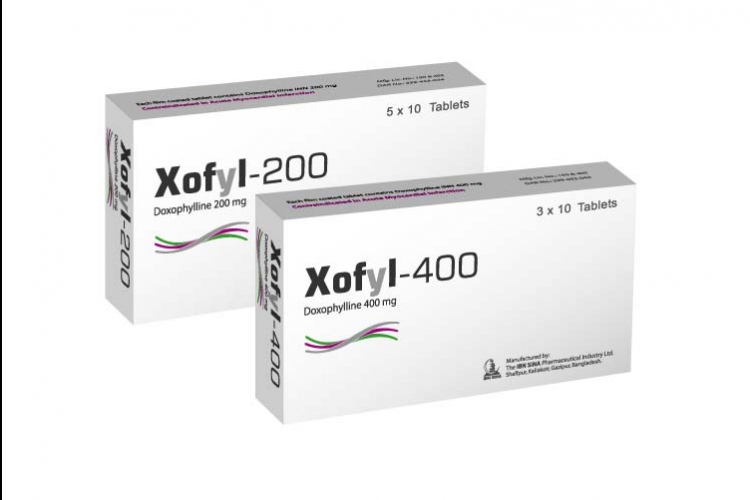
XOFYL
DOXOPHYLLINE INN
| NAME | STRENGTH | PACK SIZE | DOSAGE FORM |
|---|---|---|---|
| XOFYL 200 TABLET | 200 MG | 50 S | TABLET |
| XOFYL-400MG TABLET | 400 MG | 30 S | TABLET |
Xofyl-400 tablet: Each film coated tablet contains Doxophylline INN 400 mg. Xofyl-200 tablet: Each film coated tablet contains Doxophylline INN 200 mg.
Doxophylline is a new generation xanthine derivative which has a dioxolane group at N-7 position of its chemical structure. Doxophylline inhibits phosphodiesterase activities. Moreover, Doxophylline appears to have a less affinity towards adenosine A1 and A2 receptors which is account for the better safety profile of the drug. Doxophylline also inhibits platelet activating factor and the generation of leukotrienes.
Xofyl (Doxophylline) is used to treat asthma, COPD and bronchospasm.
Adult: 1 Tablet daily in the evening. On the basis of clinical response the dose may be increased to 1 tablet twice daily.
Children (above 6 years of age): The recommended dosage of Doxophylline is 6 mg/kg twice daily. The dose may be increased up to 18 mg/kg daily on the basis of clinical response.
Doxophylline is contraindicated in individuals who have shown hypersensitivity to its components. It is also contraindicated in patients with acute myocardial infarction and hypotension.
The half-life of xanthine derivative is influenced by a number of variables. It may be prolonged in patients with liver disease, congestive heart failure and in those patients taking certain other drugs (erythromycin, troleandomycin, lincomycin, allopurinol, cimetidine, propranolol and anti-flu vaccine). In these cases, a lower dose of Doxophylline may be needed. Phenytoin and other anticonvulsants may cause shorter mean half-life and in these cases higher doses of Doxophylline may be needed.
After administration, occasionally nausea, vomiting, headache may occur.
Use in pregnancy: Animal reproduction studies indicate that Doxophylline does not cause fetal harm when administered to pregnant animals nor can affect reproduction capacity. However, since there is limited experience in human during pregnancy, Doxophylline should be given to pregnant women only if clearly needed.
Use in nursing mothers: Doxophylline is contraindicated in nursing mothers.
Doxophylline should not be administered together with other xanthine derivatives. Toxic synergism with ephedrine has been documented for xanthines. Like other xanthines, concomitant therapy with erythromycin, troleandomycin, lincomycin, allopurinol, cimetidine, ranitidine, propranolol and anti-flu vaccine may decrease the hepatic clearance of xanthines causing an increase in blood levels.
Symptoms: Nausea, vomiting, gastroinstestinal bleeding, metabolic acidosis, hypokalaemia, hypotension, cardiac arrythmias, and seizures.
Management: Symptomatic and supportive treatment. May induce emesis or perform gastric lavage followed by administration of activated charcoal and cathartic. Establish adequate airway. IV diazepam and/or phenobarbital may be given in cases of seizure.
Store below 25oC and dry place, protect from light.
Xofyl-400 tablet: Each box contains 3 x 10's tablet in alu-alu blister pack.
Xofyl-200 tablet: Each box contains 5 x 10's tablet in alu-alu blister pack.
